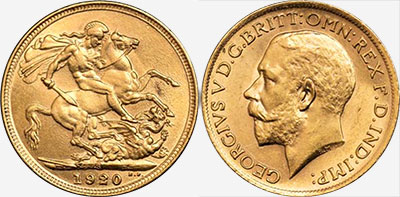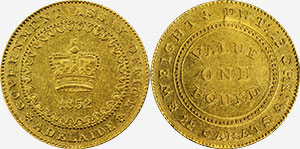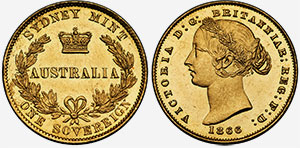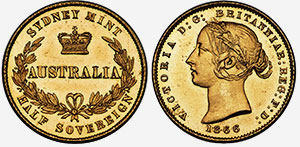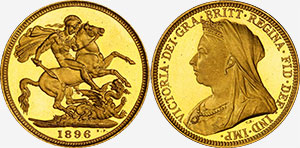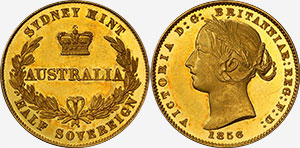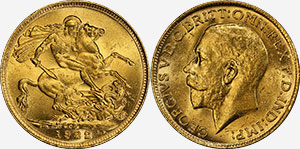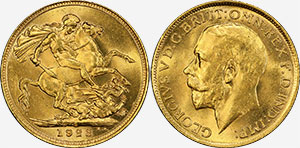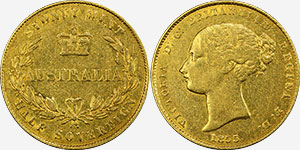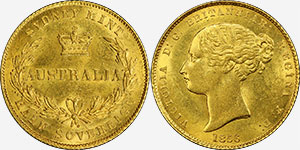Top 10 Australian certified coins sold in 2024
By CAA | Monday, 2 December 2024
Here's the list of the most expensive Australian certified coins (mostly gold) sold in 2024 so far. Prices are in Australian currency.
1. $828,000 - 1920 Sovereign Sydney - MS-63 PCGS
This exact coin sold in March 5, 2014 for $979,125 by St James' Auctions during The George Collection auction. In 2022, a MS-64 NGC example sold for $772,800.
Because of the rising price of gold (127s 4d per ounce) after World War I, the Royal Mint suspended the production of the sovereign. The mint branch in Sydney, Australia already started to produce some of them. 360,000 is the official minting of the 1920 Sydney Gold Sovereign, but only four circulating examples are known, one of them is part of the Royal Australian Mint Collection in Canberra. 1 specimen is also known.
Owing to the exemplary investigative work set forth by Howard Hodgson in his two-part article "The 1920 Sydney sovereign: A centenary review" (Coin News April/May, 2021) it is now conclusively understood from the Royal Mint Annual Report that the total mintage for the 1920-S issue was 360,180 pieces, all produced from two pairs of 1920-dated dies and struck in January and in June 1920. The mintage number for the 1920-S Sovereign may benefit from additional framing to fully appreciate the significance.
During the pre- and post-WWI era, mintages typically exceeded 1 million coins annually across Sydney, Melbourne, and Perth, with the bulk increasingly produced in Perth from the abundant gold derived from Western Australia. By 1918, production of Sovereigns surged to nearly 4 million per annum due to wartime demands, while production of half Sovereigns ceased in 1917 as they were deemed unnecessary for commerce. Hodgson's article highlights a drastic shift in 1920 towards minting smaller denominations like Pence and Halfpence to satisfy the Commonwealth Treasury's wishes. The rarity of the 1920-S Sovereign is attributed largely to most of its mintage being melted down with 105 million other Sovereigns in the late 1920s and early 1930s in the US and England. While previous scholarship suggested these rare coins were commissioned by Sydney's Jacob Garrard for his Golden Wedding Anniversary, Hodgson refutes this, indicating no formal order has been located, and suggesting Garrard much more likely sourced them from the Commonwealth Bank, which received new Sovereigns directly from the Sydney Mint during the 1920s.
Hodgson further stipulates the survival of the Garrard family coins is likely attributable to the fact they remained safely tucked away in Australia and thus avoided the melting pots of the UK and the USA. As such, it is notable that the 1920-S represents what is perhaps the paramount rarity of the regular circulation Sovereign series, rather than a subset minted to order. Currently, the following additional examples are known to the public eye, in addition to the at least two coins mentioned by Hodgson that reside in the Garrard family possessions. What happened to the Dixson Collection example in the State Library of New South Wales which was replaced with a fake by the infamous forger David Gee, remains a mystery to this date and a story for another time.
Sepcifications
- Composition: 91.67% gold and 8.33% copper
- Weight: 7.9881 g
- Diameter: 21.5 mm
- Obverse: E.B. Mackennal
- Reverse: B. Pistrucci
1920 Sydney Gold Sovereign - Rarest Sovereign of Australia
2. $117,000 - Adelaide One Pound 1852 Type 1 - AU-55 PCGS
This is the rarest type, with a die crack before D of DWT. A very few pieces had been struck from the first of two dies creating this coin.
Last year, another Type 1 example certified MS-62 NGC sold for $330,600.
Because of the tremendous shortage of coins at that time in Australia and while gold dust and nuggets were in ample supply, it was decided to create one pound coins as a way to convert that gold into circulating currency. But the government of South Australia, didn't wait for Royal assent and England approval, saying that the Assay Office was not a legal entity and should not be striking the coins, before producing a short quantity of these one pound gold coins. Therefore, the amended 1852 Bullion Act was rejected.
It is estimated that out of the total recorded mintage of 24,648 only less than 50 were produced with Type 1 reverse die. At PCGS only three Type 1B 'coarse reeding' (like this one) examples are witnessed, compared to six Type 1A 'fine reeding' pieces.
In 1852, South Australia introduced not a conventional coin, but a meticulously crafted coin-shaped ingot, guaranteed to hold the value of a pound. With exact specifications of purity (22 carats) and weight (5 pennyweight and 15 grains) provided by the colony, the ingots were produced from gold transported from the Victorian goldfields.
Despite its technical illegality as minted without Royal Assent, these ingots were commissioned by the South Australian government to address a pressing economic dilemma arising from the mass migration of able-bodied men of the state to the Victorian gold fields, which critically drained the colony's monetary resources and indeed, threatened its very survival as a crucial part of workforce required for farming was absent. Remarkably, before the formal authorization request was processed in England and the subsequent refusal reached Adelaide, the Adelaide Assay Office had already taken decisive action, issuing these tokens and stopped the minting, and in doing so effectively resolved the economic crisis.
Sepcifications
- Composition: 91.67% gold and 8.33% copper
- Weight: 8.69 g
- Diameter: 23 mm
- Edge: Milled (both fine and wide reeding exist)
Adelaide One Pound 1852 Price Guide and Values »
3. $79,200 - 1866 Sovereign - MS-63PL PCGS
Earned the Prooflike designation with its mirroring fields and the frost on the devices.
The only piece awarded a Prooflike superlative at PCGS and highly covetable as such, offering a possibly unique opportunity to acquire a Proof-resembling Sydney Sovereign at a fraction of a true Proof coin's price.
- Heritage Auctions
Sepcifications
- Composition: 91.67% gold and 8.33% copper
- Diameter: 22 mm
4. $75,600 - 1866 Half-Sovereign - MS-63PL PCGS
The only certified example at PCGS designated with Prooflike superlative.
Sepcifications
- Composition: 91.67% gold and 8.33% copper
- Diameter: 19 mm
5. $62,000 - 1896 Sovereign - PR-65+ PCGS
Only 3 proof examples known. Ex J.G. Murdoch Collection, Sothebys 1904 (lot 640) and IAG Sale 76 Sep 2021 (Lot 327).
Sepcifications
- Composition: 91.67% gold and 8.33% copper
- Diameter: 22 mm
6. $60,000 - 1856 Half-Sovereign - PR-62 PCGS
Obverse Type I and reverse Type II, no berry above L of HALF. In March 2010, a similar one sold for around $65,000.
In 2022, a PR-65+ NGC example sold for $201,600. In 2023, it sold again for $208,800.
Sepcifications
- Composition: 91.67% gold and 8.33% copper
- Diameter: 19 mm
7. $54,000 - 1922 Sovereign Sydney - MS-63 PCGS
Despite an original mintage of nearly 600,000, the intensive circulation of Australian and South African sovereigns in the international economy post-WWI led to vast numbers being transferred to and from London. The Bank of England ultimately melted nearly 100 million sovereigns, including many recently minted overseas issues like this 1922 Sydney emission.
Sepcifications
- Composition: 91.67% gold and 8.33% copper
- Diameter: 22 mm
8. $50,400 - 1923 Sovereign Sydney - MS-63 PCGS
A MS-62 NGC example sold for $22,464 in 2022.
Sepcifications
- Composition: 91.67% gold and 8.33% copper
- Diameter: 22 mm
9. $43,200 - 1855 Half-Sovereign - EF-45 PCGS
Among the toughest in the entire Victorian half Sovereign collection to acquire in any meaningful condition.
Sepcifications
- Composition: 91.67% gold and 8.33% copper
- Diameter: 19 mm
10. $39,600 - 1856 Half-Sovereign - MS-62 PCGS
Variety with the berry above L of HALF.
Sepcifications
- Composition: 91.67% gold and 8.33% copper
- Diameter: 19 mm
Pictures by Heritage Auctions, IAG and PCGS.

